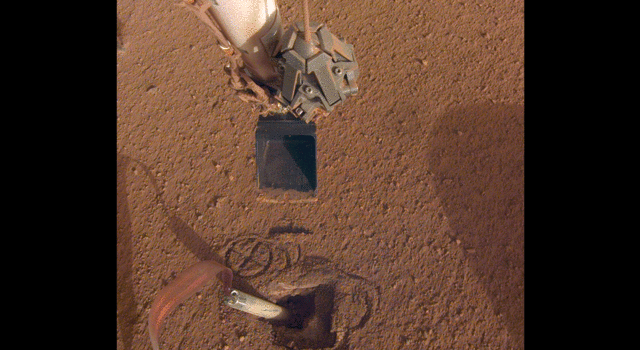3.11.2019
INSIGHT’S MOLE MAY NOT DELIVER ON HEAT FLOW, BUT REVEAL MYSTERIES OF MARTIAN SOIL INSTEAD
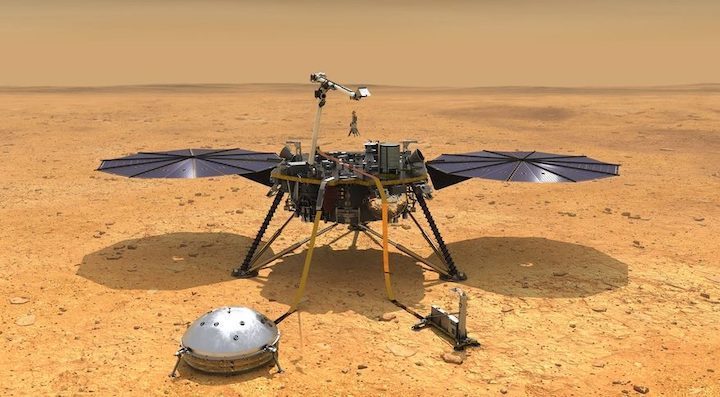
One of the instruments on NASA’s Insight Mars lander, called a mole, is behaving unexpectedly. Scientists are still trying to understand why, but even if it ultimately cannot deliver on providing measurements of the planet’s heat flow, all is not lost. In an interview, Principal Investigator Bruce Banerdt pointed out that new data about the properties of Martian soil could be an unexpected bonus that will inform future exploration by robots and humans.
NASA’s Interior Exploration using Seismic Investigations, Geodesy and Heat Transport (InSight) spacecraft landed on Mars almost exactly a year ago. It carries two scientific instruments, one built by the French space agency CNES and the other by Germany’s space agency DLR, plus radio equipment that also is being used for science investigations.
DLR’s Heat Flow and Physical Properties Package, or HP3, is designed to take Mars’s temperature to determine how much heat is flowing out of the planet’s interior. That will tell scientists whether Earth and Mars formed from the same “stuff” and how active Mars is today.
To collect the data, a probe affectionately called the “mole” needs to be inserted deep into the soil — as much as 5 meters (16 feet). It uses a self-hammering device that relies on friction with the Martian soil to burrow downwards instead of bouncing in place due to recoil from the hammer.
When mission controllers first tried it, however, the mole only descended about 35 centimeters (14 inches). Theorizing that the soil was not providing enough friction, they used a scoop at the end of Insight’s robotic arm to pin the mole against the side of its hole and get that necessary friction. In this NASA video, the black scoop is in the center, with the cylindrical mole and its trailing tether of wires to the left.
Instead, the opposite occurred. The mole started backing out of the hole.
No one know why. DLR and NASA scientists and engineers are assessing the situation before deciding on what to try next. They do not want to make anything worse.
Determining Mars’s heat flow is very important scientifically, but typically would be obtained using a drill, which is quite expensive. Insight is a cost-capped Discovery-class mission and this probe method was chosen because it was affordable even though it meant a higher risk of failure.
In an interview on Friday, JPL’s Banerdt told SpacePolicyOnline.com that when he proposed the project to NASA as part of the Discovery selection process, he listed 10 Level 1 science requirements it would achieve. Because of the cost cap and the possibility that some experiments might have to be descoped or even eliminated to stay under it, those were separated into six “threshold” requirements that must be met to claim overall mission success and four “baseline” requirements that were highly desired but not as critical.
The HP3 data is one of the baseline, not threshold, Level 1 requirements. The threshold requirements will be met by the Seismic Experiment for Interior Structure (SEIS) that is listening for Marsquakes or the radio science Rotation and Interior Structure Experiment (RISE).

The CNES-built SEIS experiment had its own troubles before launch, causing a two-year delay in Insight’s launch. It appears to be working well now.
Banerdt said the design of the HP3 mole was based on scientific understanding of the Martian soil from previous NASA landers and rovers dating back to the 1970s. The soil at the sites explored by Viking, Spirit, Opportunity and Curiosity had differences, but were sufficiently consistent to inform the design of HP3.
Or so they thought.
What is causing the mole to behave so unexpectedly remains to be determined, but Banerdt sounded intrigued. Scientists discovered a thin layer of duricrust, a type of cemented soil, in the area explored by Spirit (which is part of the reason it got stuck), but the duricrust is much thicker at Insight’s location. That may suggest a different formation process on that part of Mars.
“We’re getting some really fascinating data” about the mechanical properties of the soil and near subsurface that are likely to yield many scientific papers, he enthused.
As NASA develops its plans to send humans to Mars as early as the 2030s, understanding soil characteristics will be critical for everything from habitation to resource extraction and utilization. “We have limited experience with digging on Mars,” so whatever happens with HP3’s efforts to measure heat flow, we “definitely will get some good science.”
As for measuring the temperature of Mars, if the problem cannot be resolved, it may require the more expensive drilling approach. That would have to be prioritized against other Mars science questions in the next planetary science Decadal Survey.
But it also would inform what needs to be done to establish self-sufficient habitation on Mars. Heat flow is a “key measurement for understanding the equivalent of geothermal power” or the depth of possible aquifers where temperatures are conducive to liquid water. “Doing it on a Discovery budget” was a known risk, Banerdt emphasized, but HP3 will result in important scientific knowledge even if that goal is not achieved.
Happy Mars-iversary, InSight! NASA Lander Marks 1 Year on Red Planet
InSight touched down near the Martian equator on Nov. 26, 2018.
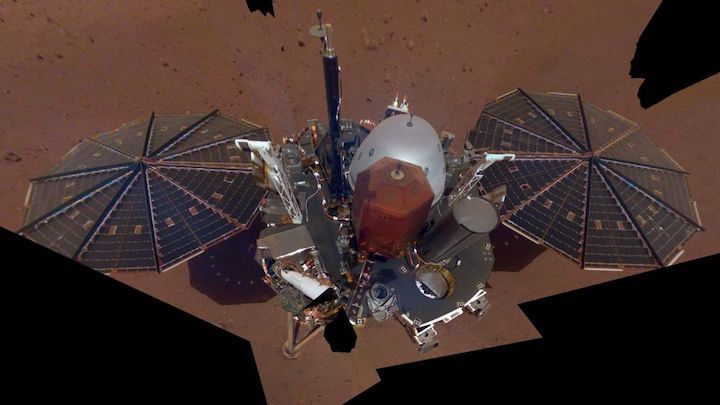
How time does fly: NASA's InSight Mars lander has now been on the Red Planet for a full (Earth) year.
InSight aced its "6 minutes of terror" entry, descent and landing on Nov. 26, 2018, setting off some wild and delightfully nerdy celebrations at NASA's Jet Propulsion Laboratory in Pasadena, California, which runs the mission.
The past year has been a very eventful one for the stationary InSight, which is probing the Martian interior like never before. The lander's supersensitive seismometer suite has detected more than 150 vibration events to date, about two dozen of which are confirmed marsquakes. But InSight's other primary science instrument, a burrowing heat probe called the Heat Flow and Physical Properties Package (HP3), has had tougher sledding.
HP3's self-hammering tool, dubbed "the mole," has been able to dig the instrument just a foot (0.3 meters) or so underground to date, instead of the desired 10 to 16 feet (3 to 5 m). The mole has also popped out of its burrow unexpectedly. InSight team members are troubleshooting these issues, which may be caused by the weirdness of Mars' soil, and they've made some progress recently.
The solar-powered InSight is scheduled to operate for at least two Earth years on the Martian surface. The data gathered by the mission, whose name is short for "Interior Exploration using Seismic Investigations, Geodesy and Heat Transport," should help scientists better understand how rocky planets form and evolve, NASA officials have said.
Yesterday wasn't the only anniversary for a NASA Mars robot. The agency's Curiosity rover launched from Florida on Nov. 26, 2011, kicking off an eight-month cruise to the Red Planet. The nuclear-powered Curiosity has determined that its landing site, the floor of the 96-mile-wide (154 kilometers) Gale Crater, could have supported Earth-like life in the ancient past. And the car-size rover is still going strong today, climbing up the slopes of the 3.4-mile-high (5.5 km) mountain that rises from Gale's center.
Quelle: SC
----
Update: 17.12.2019
.
UPDATED at 12 p.m. EST (9 a.m. PST) on Nov. 6, 2019
The InSight team continues to assess the heat probe this week. Having determined the lander's robotic arm wasn't holding the mole in place, they retracted the arm and took new images to see how the pit that formed around the mole has changed. What the team sees will help determine next steps. The intention is to press the robotic arm's scoop against the mole again — a technique referred to as "pinning" — but further lab testing on Earth will be needed before any steps are taken on Mars.
For common questions and answers about the mole, visit this page.
UPDATED 4:22 pm EDT (1:22 pm PDT), Oct. 27, 2019
Mars InSight's Mole Has Partially Backed Out of Its Hole
After making progress over the past several weeks digging into the surface of Mars, InSight's mole has backed about halfway out of its hole this past weekend. Preliminary assessments point to unusual soil conditions on the Red Planet. The international mission team is developing the next steps to get it buried again.
A scoop on the end of the arm has been used in recent weeks to "pin" the mole against the wall of its hole, providing friction it needs to dig. The next step is determining how safe it is to move InSight's robotic arm away from the mole to better assess the situation. The team continues to look at the data and will formulate a plan in the next few days.
Meantime, the lander's seismometer — the Seismic Experiment for Interior Structure, or, SEIS — continues to collect data on marsquakes in order to provide a better understanding of the Mars interior and why Earth and the Red Planet are so different today after sharing similarities billions of years ago. The French space agency, Centre National d’Études Spatiales (CNES) and its partners provided the SEIS instrument to NASA.
Original story posted October 17, 2019
Mars InSight's 'Mole' Is Moving Again
NASA's InSight spacecraft has used its robotic arm to help its heat probe, known as "the mole," dig nearly 2 centimeters (3/4 of an inch) over the past week. While modest, the movement is significant: Designed to dig as much as 16 feet (5 meters) underground to gauge the heat escaping from the planet's interior, the mole has only managed to partially bury itself since it started hammering in February 2019.
The recent movement is the result of a new strategy, arrived at after extensive testing on Earth, which found that unexpectedly strong soil is holding up the mole's progress. The mole needs friction from surrounding soil in order to move: Without it, recoil from its self-hammering action will cause it to simply bounce in place. Pressing the scoop on InSight's robotic arm against the mole, a new technique called "pinning," appears to provide the probe with the friction it needs to continue digging.
Since Oct. 8, 2019, the mole has hammered 220 times over three separate occasions. Images sent down from the spacecraft's cameras have shown the mole gradually progressing into the ground. It will take more time — and hammering — for the team to see how far the mole can go.
The mole is part of an instrument called the Heat Flow and Physical Properties Package, or HP3, which was provided by the German Aerospace Center (DLR).
"Seeing the mole's progress seems to indicate that there's no rock blocking our path," said HP3 Principal Investigator Tilman Spohn of DLR. "That's great news! We're rooting for our mole to keep going."
NASA's Jet Propulsion Laboratory in Pasadena, California, leads the InSight mission. JPL has tested the robotic arm's movement using full-scale replicas of InSight and the mole. Engineers continue to test what would happen if the mole were to sink beneath the reach of the robotic arm. If it stops making progress, they might scrape soil on top of the mole, adding mass to resist the mole's recoil.
If no other options exist, they would consider pressing the scoop down directly on the top of the mole while trying to avoid the sensitive tether there; the tether provides power to and relays data from the instrument.
"The mole still has a way to go, but we're all thrilled to see it digging again," said Troy Hudson of JPL, an engineer and scientist who has led the mole recovery effort. "When we first encountered this problem, it was crushing. But I thought, 'Maybe there's a chance; let's keep pressing on.' And right now, I'm feeling giddy."
About InSight
JPL manages InSight for NASA's Science Mission Directorate. InSight is part of NASA's Discovery Program, managed by the agency's Marshall Space Flight Center in Huntsville, Alabama. Lockheed Martin Space in Denver built the InSight spacecraft, including its cruise stage and lander, and supports spacecraft operations for the mission.
A number of European partners, including France's Centre National d'Études Spatiales (CNES) and the German Aerospace Center (DLR), are supporting the InSight mission. CNES provided the Seismic Experiment for Interior Structure (SEIS) instrument to NASA, with the principal investigator at IPGP (Institut de Physique du Globe de Paris). Significant contributions for SEIS came from IPGP; the Max Planck Institute for Solar System Research (MPS) in Germany; the Swiss Federal Institute of Technology (ETH Zurich) in Switzerland; Imperial College London and Oxford University in the United Kingdom; and JPL. DLR provided the Heat Flow and Physical Properties Package (HP3) instrument, with significant contributions from the Space Research Center (CBK) of the Polish Academy of Sciences and Astronika in Poland. Spain's Centro de Astrobiología (CAB) supplied the temperature and wind sensors.
Quelle: NASA
+++
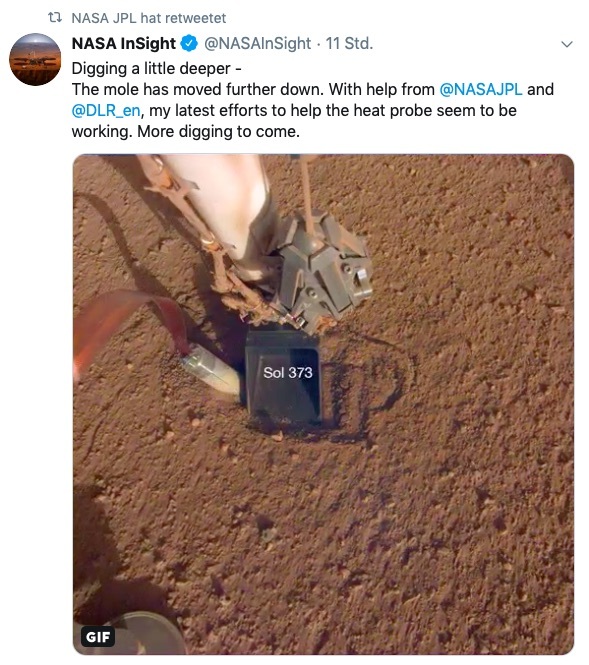
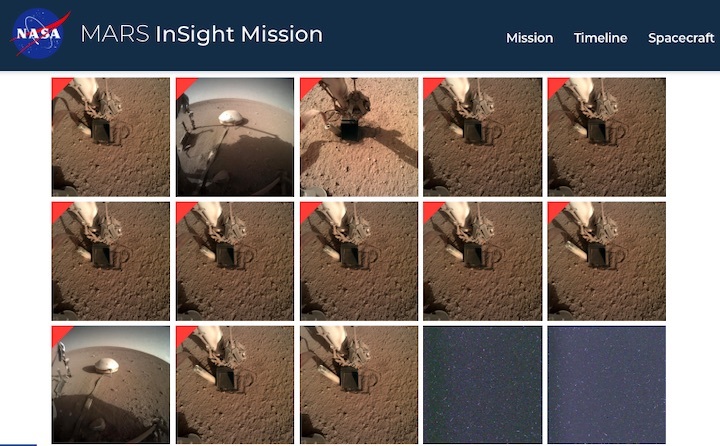
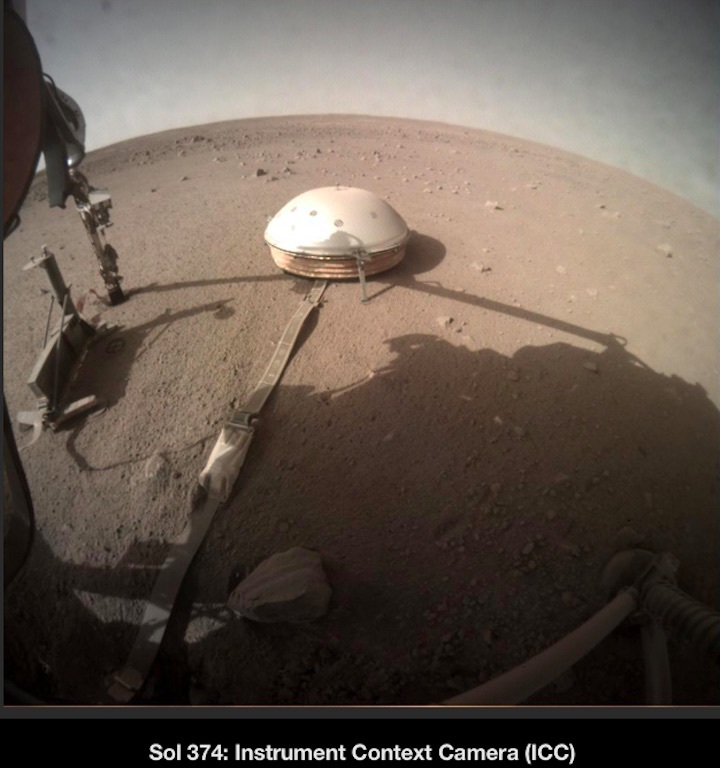
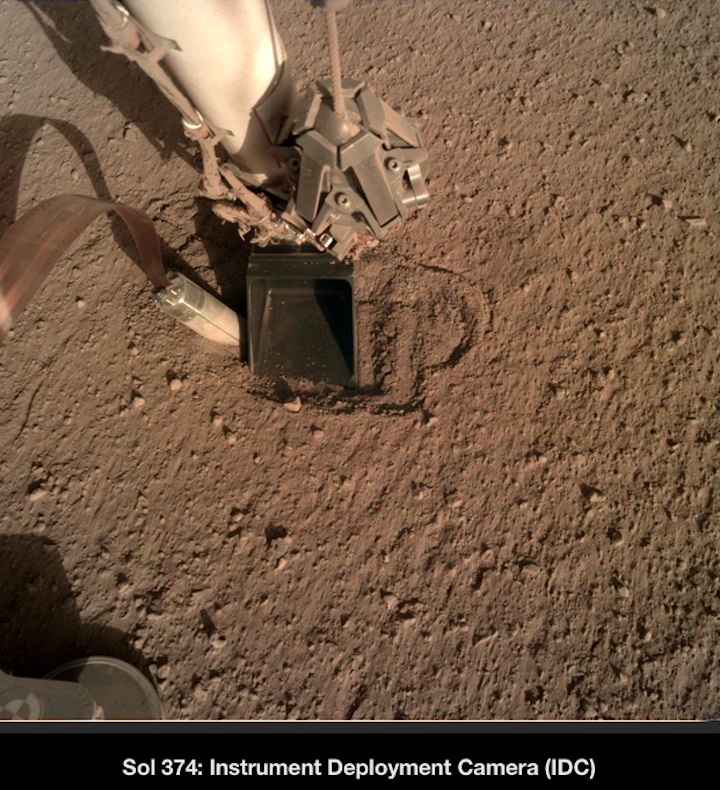
Quelle: NASA
----
Update: 19.12.2019
.
NASA's Mars Lander 'Mole' Is Digging Again as Marsquake Mystery Baffles Scientists
The troubled "mole" on NASA's InSight Mars lander is moving again, even as scientists working on the robot's seismometer ponder new marsquake mysteries.
InSight touched down in November 2018 on a quest to understand the interior of the Red Planet. Two of its crucial tools for that task were a burrowing heat probe nicknamed the mole and a super-sensitive seismometer to study motion within the planet.
But soon after spacecraft personnel told the mole to get digging, something went wrong, and scientists and engineers affiliated with the mission have been strategizing ways to get the instrument moving ever since.
The team photographed the situation from every angle possible, pondered the likelihood of hidden rocks, evaluated soil characteristics and mimicked the situation with a replica instrument here on Earth. At one point in October, the mole popped out of Mars, as if it had simply had enough of the whole situation.
Most recently, the InSight team tried maneuvering the lander's arm to gently press sideways on the mole. On Nov. 21, NASA announced that the technique had successfully let the probe dig itself down about 1.25 inches (32 millimeters). And on Dec. 16, the agency said that the mole was continuing to burrow properly.
The update did not include details on how far the probe has moved, but a gif accompanying the tweet suggests that the probe, which measures 15.7 inches (400 mm) in length, dug about 2.5 inches (65 mm) between and Dec. 7 and Dec. 14. "More digging to come," the update concluded.
A Martian seismic mystery
Meanwhile, the team working on InSight's seismometer is also keeping busy. On Dec. 16, the group posted that "significant" marsquakes detected on May 22 and July 25 originated in a tectonic structure called Cerberus Fossae, making the area "the first active seismic zone ever discovered on Mars," according to a statementposted to the instrument's Twitter feed.
However, the scientists working with the instruments are waiting to share more information about the discovery until research papers on the topic are published.
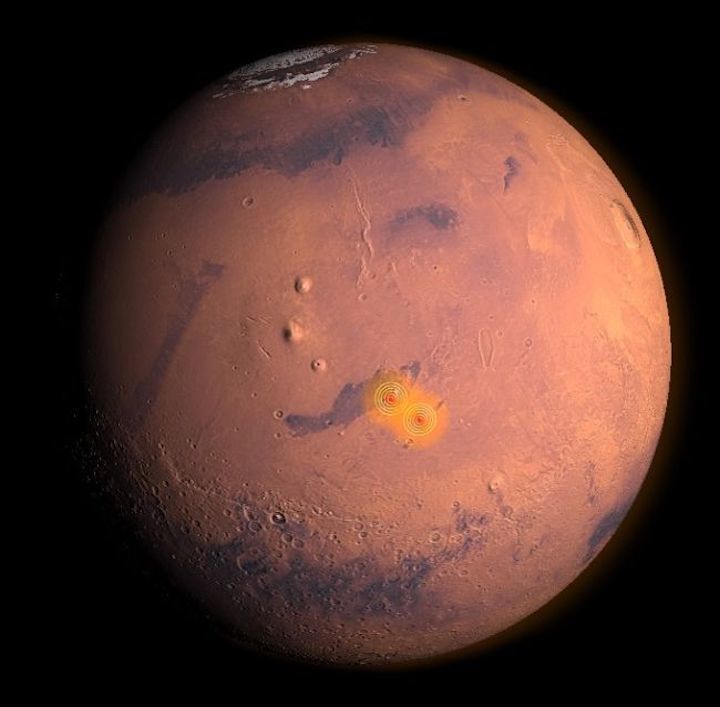
The same instrument team announced today (Dec. 18) in a similarly brief updatethat the seismometer seems to have detected a new phenomenon as well.
"The @NASAInSight seismometer has discovered a strange, continuous signal at 2.4 Hz, apparently not related to the lander or weather activity, but excited by a lot of #MarsQuake," the statement read. "This puzzling resonance acts as a natural seismic amplifier!" What that means for the planet remains unclear.
"Mars is full of mysteries," the team wrote.
Quelle: SC
----
Update: 22.02.2020
.
InSight to try to push mole into Martian surface
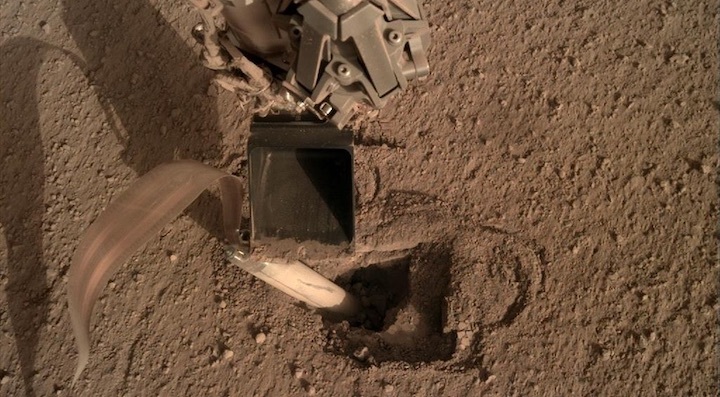
WASHINGTON — Engineers plan to use the robotic arm on its InSight Mars lander to push a heat flow probe into the surface, acknowledging that they have “few alternatives” if that effort fails.
The Heat Flow and Physical Properties Package instrument team has spent nearly a year trying to get the instrument’s probe, or “mole,” to burrow into the surface. The mole has an internal hammering mechanism that is designed to drive the probe as deep as five meters into the surface in order to measure the heat flow from the planet’s interior.
The mole, though, stopped only about 30 centimeters below the surface. The mission has tried a number of ways to get the mole moving again, including removing the instrument housing on the surface to allow the lander’s robotic arm to try and fill in the hole created by the mole, as well as pin the mole to one side of that hole, increasing the friction needed for the mole to work its way into the surface.
In October, that use of the arm to pin the mole worked briefly, allowing the mole to burrow into the surface, only for it to rebound partially out of the hole. A second attempt led to the mole again rebounding partially out of the hole in January.
In a Feb. 21 statement, NASA’s Jet Propulsion Laboratory said it will instead use the robotic arm to push on the top, or “back cap,” of the mole in an effort to force the mole into the ground. Engineers had avoided using that approach before out of concerns it could damage the tether extending from that back cap to the main body of the instrument on the surface.
“After the team’s experience of operating the scoop, we all became more confident that the risk of accidental damage to the tether (with its power and data lines) was small enough to be worth taking,” Tilman Spohn, principal investigator for the instrument at the German space agency DLR, wrote in a Feb. 21 blog post.
Scientists believe that InSight landed in a region with a thick “duricrust” of regolith not seen elsewhere on the surface. The mole was designed to use friction from looser regolith to move into the surface, and the duricrust may be causing the mole to rebound when it hammers.
This latest effort to get the mole into the surface will take place in late February and early March. Engineers may also use the robotic arm to put more regolith into the hole around the mole.
It’s not clear what the next steps would be if this attempt to push against the mole’s back cap fails. The JPL statement noted that engineers decided on this approach because there were “few alternatives left” to try to the get the mole into the surface.
Quelle: SN
+++
NASA's Mars InSight Lander to Push on Top of the 'Mole'
Engineers have a plan for pushing down on the heat probe, which has been stuck at the Martian surface for a year.
After nearly a year of trying to dig into the Martian surface, the heat probe belonging to NASA's InSight lander is about to get a push. The mission team plans to command the scoop on InSight's robotic arm to press down on the "mole," the mini pile driver designed to hammer itself as much as 16 feet (5 meters) down. They hope that pushing down on the mole's top, also called the back cap, will keep it from backing out of its hole on Mars, as it did twice in recent months after nearly burying itself.
Part of an instrument called the Heat Flow and Physical Properties Package, or HP3, the mole is a 16-inch-long (40-centimeter-long) spike equipped with an internal hammering mechanism. While burrowing into the soil, it is designed to drag with it a ribbonlike tether that extends from the spacecraft. Temperature sensors are embedded along the tether to measure heat coming deep from within the planet's interior to reveal important scientific details about the formation of Mars and all rocky planets, including Earth. HP3 was provided to NASA by the German Aerospace Center, or DLR.
The team has avoided pushing on the back cap until now to avoid any potential damage to the tether.
The mole found itself stuck on Feb. 28, 2019, the first day of hammering. The InSight team has since determined that the soil here is different than what has been encountered on other parts of Mars.InSight landed in an area with an unusually thick duricrust, or a layer of cemented soil. Rather than being loose and sandlike, as expected, the dirt granules stick together.
The mole needs friction from soil in order to travel downward; without it, recoil from its self-hammering action causes it to simply bounce in place. Ironically, loose soil, not duricrust, provides that friction as it falls around the mole.
This past summer, the InSight team started using the robotic arm's scoop to press on the side of the mole, a technique called "pinning" that added just enough friction to help it dig without coming in contact with the fragile science tether connected to the mole's back cap.
While pinning helped, the mole popped back out of the Martian soil on two occasions, possibly from soil building up from beneath. With few alternatives left, the team has decided to try helping the mole dig by carefully pressing on its back cap while attempting to avoid the tether.
It might take several tries to perfect the back-cap push, just as pinning did. Throughout late February and early March, InSight's arm will be maneuvered into position so that the team can test what happens as the mole briefly hammers.
Meanwhile, the team is also considering using the scoop to move more soil into the hole that has formed around the mole. This could add more pressure and friction, allowing it to finally dig down. Whether they pursue this route depends on how deep the mole is able to travel after the back-cap push.
About InSight
JPL manages InSight for NASA's Science Mission Directorate. InSight is part of NASA's Discovery Program, managed by the agency's Marshall Space Flight Center in Huntsville, Alabama. Lockheed Martin Space in Denver built the InSight spacecraft, including its cruise stage and lander, and supports spacecraft operations for the mission.
A number of European partners, including France's Centre National d'Études Spatiales (CNES) and the German Aerospace Center (DLR), are supporting the InSight mission. CNES provided the Seismic Experiment for Interior Structure (SEIS) instrument to NASA, with the principal investigator at IPGP (Institut de Physique du Globe de Paris). Significant contributions for SEIS came from IPGP; the Max Planck Institute for Solar System Research (MPS) in Germany; the Swiss Federal Institute of Technology (ETH Zurich) in Switzerland; Imperial College London and Oxford University in the United Kingdom; and JPL. DLR provided the Heat Flow and Physical Properties Package (HP3) instrument, with significant contributions from the Space Research Center (CBK) of the Polish Academy of Sciences and Astronika in Poland. Spain's Centro de Astrobiología (CAB) supplied the temperature and wind sensors.
Quelle: NASA
----
Update: 25.02.2020
.
Nasa's InSight probe senses hundreds of 'Marsquakes'
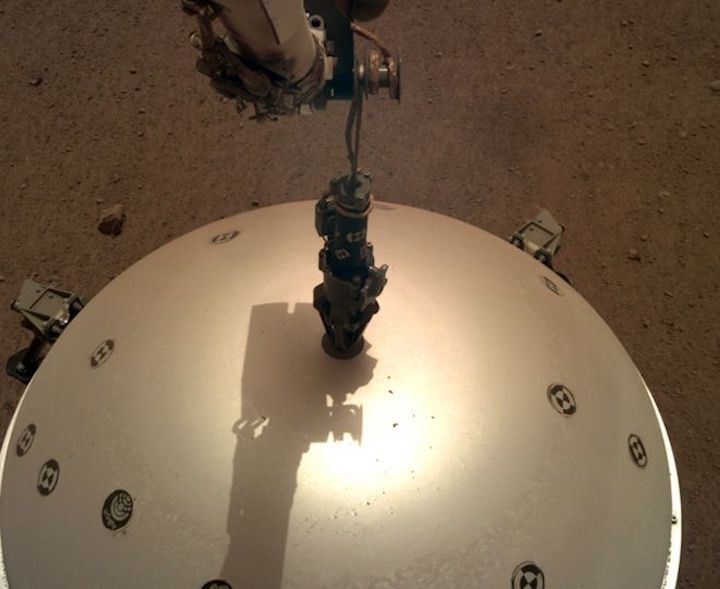

Things go bump on Mars on a fairly regular basis. That's the conclusion of a year of listening for quake signals on the planet by the InSight lander.
The US space agency-led probe has detected over 450 significant seismic events since touching down in 2018.
None are particularly big - at most, they're only 3 to 4 on the magnitude scale, which you might feel if you were standing directly above the tremors.
The quakes' size and frequency is actually not that dissimilar to the UK.
The important message though to take away from the first detailed reports on the progress of the InSight mission is that Mars is far from being a dull, dead planet; it's an active one, says principal investigator Bruce Banerdt.
He told reporters: "We finally for the first time have established that Mars is a seismically active planet and that the seismic activity is greater than that of the Moon, which was measured back during the Apollo programme, but less than that of the Earth (as a whole).
"In fact, it's probably close to the kinds of seismic activity you would expect to find away from the plate boundaries on the Earth and away from highly deformed areas."
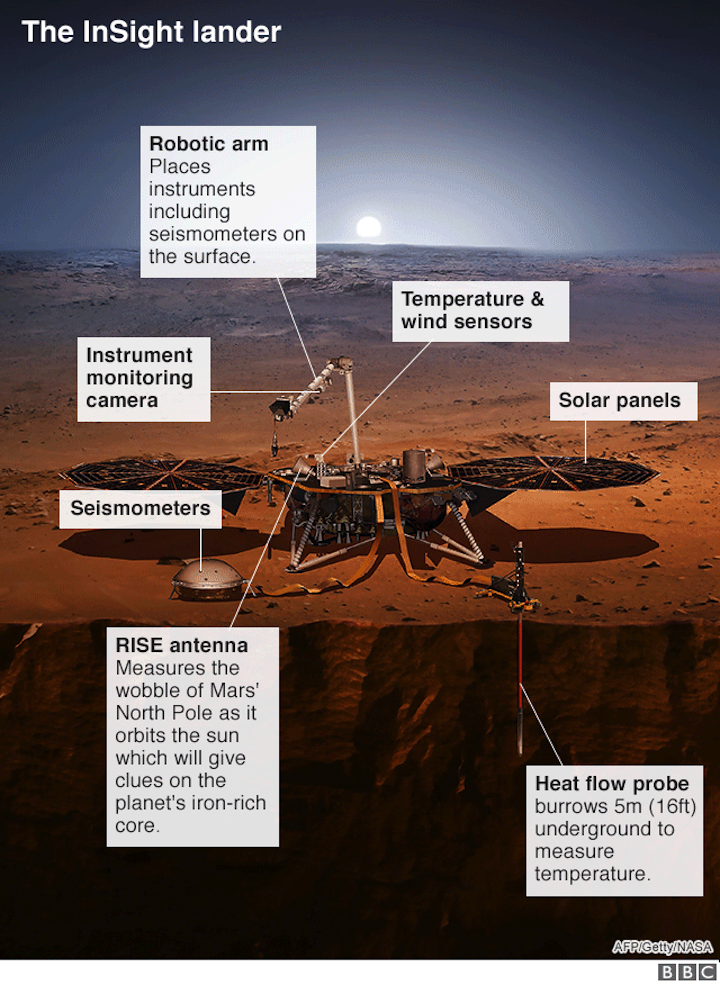
That's pretty much the quake picture in Britain "give or take a factor of two", added Tom Pike from Imperial College London.
A magnitude 4 event in the UK will occur on average roughly every two years.
InSight arrived on Mars on 26 November 2018, touching down in an equatorial region of the planet known as Elysium Planitia. It settled in a small crater that has been informally named Homestead Hollow.
In addition to its French-UK seismometer package, the probe is equipped with a heat sensor that aims to burrow into the ground, and an exquisite radio experiment that will measure how the planet wobbles on its axis.
Taken together, Insight's data should reveal the position and nature of all the rock layers below the surface of Mars - from the crust to the core. It's information that can then be compared and contrasted with Earth.
The results released on Monday - and published in a series of papers in Nature and Nature Geoscience - represent just the early phase in this science quest which could take some years to fulfil.
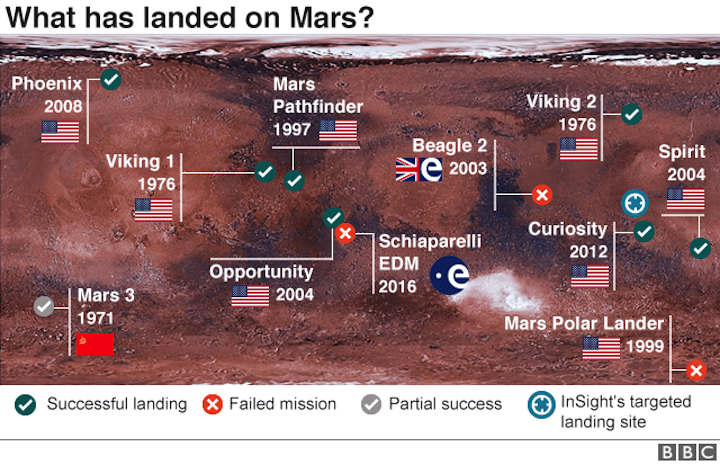
Mars shows no obvious evidence of plate tectonics, of great slabs of rock jostling across its surface, which is the driving mechanism of quake activity on Earth.
Instead, much of the quake behaviour on the Red Planet is likely the result of cooling and contraction. As Mars loses heat, it shrinks and its brittle outer skin then fractures in response.
The probe's seismometers, although representing just a single station, do have some ability to locate the source of the bigger quakes and in Monday's published catalogue there are a number of events that have been pinpointed to a nearby terrain referred to as Cerberus Fossae.
This is an area of Mars that satellite imagery has suggested may have experienced volcanism in the geologically recent past. In other words, within the last 10 million years.
"It's possible that there's actual magma at depth that's cooling," speculated InSight deputy project scientist Suzanne Smrekar.
"And as that (possible) magma chamber contracts, it causes deformation of the strong part (of the crust) - the lithosphere.
"We don't have information from our quakes that say that this is what's going on. It's a hypothesis of how we connect what we see at the surface to the fact that we are observing Marsquakes in that region."
Some modelling is required to trace the quakes back to Cerberus Fossae. That's in part because, so far, the mission still doesn't have great velocity data for the propagation seismic waves through Mars' rocks.
"We need to know what the velocities are to properly work out a distance," explained Prof Pike whose team developed the high-frequency sensors in InSight's seismometer package.
"To do that we need either to unambiguously locate the quake separately, which we could do from a meteorite strike, but we haven't detected one of those yet; or by having a strong enough event that the waves would go around the planet twice, which is what most earthquakes on Earth do. And because we know the diameter of the planet - that would give us a calibration," he told BBC News.
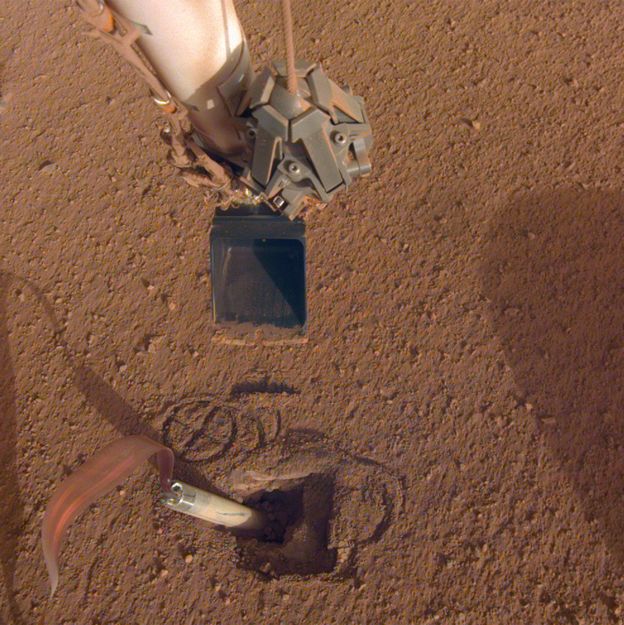 Image copyrightNASA/JPL-CALTECH
Image copyrightNASA/JPL-CALTECH

Indeed, to get a more resolved view of Mars' interior, the team could really do with detecting the Red Planet equivalent of a "Big One". Even just one very large event could make a big difference to the overall analysis.
Dr Banerdt said he remained hopeful: "It's the nature of statistics - sometimes things are clustered, sometimes there's large gaps in between. It's definitely not out of the question that we could see a couple of large quakes in the next few months."
InSight is currently financed by the US space agency to continue gathering data for another Earth year.
At the end of that period, it hopes also to have results from the radio experiment which should yield information on the size and density of the planet's core; and also from its heat-flow sensor. The latter is designed to burrow under the surface to measure the rate of Mars' heat loss but the hardware has had difficulty getting into position.
Engineers plan shortly to command InSight's robotic arm to push on the sensor to help it get underground.
Quelle: BBC



